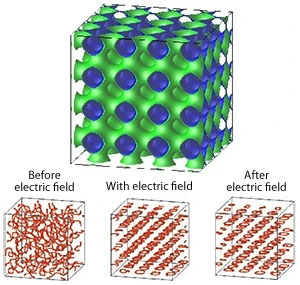Liquid Crystal Nanoparticles: Merging the Worlds of Liquid Crystals and Nanotechnology
What are Liquid Crystal Nanoparticles?
Liquid crystal nanoparticles (LCNPs) are a unique class of nanomaterials that combine the properties of liquid crystals with the advantages of nanoparticles. These hybrid particles exhibit the orientational order and responsiveness of liquid crystals while possessing the small size, large surface area, and quantum confinement effects of nanoparticles. This synergistic combination opens up new possibilities for advanced applications in various fields, including displays, sensors, drug delivery, and photonics.

Structure and Properties of LCNPs
LCNPs are typically spherical or nearly spherical particles with diameters ranging from a few nanometers to several hundred nanometers. They consist of a liquid crystalline core surrounded by a stabilizing shell or surface modification. The internal structure of LCNPs is characterized by the self-assembly of liquid crystal molecules into ordered domains, such as nematic, smectic, or cholesteric phases, depending on the specific liquid crystal material used.
The properties of LCNPs are governed by both the liquid crystalline nature of the core and the nanoscale dimensions of the particles. Some key properties include:
- Orientational Order: The liquid crystal molecules within LCNPs exhibit long-range orientational order, which can be controlled by external stimuli such as electric or magnetic fields, temperature, or light.
- Optical Anisotropy: Due to the ordered arrangement of the liquid crystal molecules, LCNPs exhibit optical anisotropy, meaning their optical properties depend on the direction of light propagation and polarization.
- Responsiveness: LCNPs can respond to various external stimuli by changing their orientational order, shape, or optical properties. This responsiveness enables their use in stimuli-responsive materials and devices.
- Enhanced Surface Area: The small size of LCNPs results in a large surface area-to-volume ratio, which enhances their interaction with the surrounding environment and facilitates surface functionalization.
Synthesis of LCNPs
Several methods have been developed for the synthesis of LCNPs, each with its own advantages and limitations. Some common synthesis approaches include:
Emulsion-Based Methods
Emulsion-based methods involve the dispersion of liquid crystal droplets in an immiscible continuous phase, followed by solidification or polymerization of the droplets. This approach allows for the control of particle size and morphology by adjusting the emulsion parameters, such as the surfactant type and concentration, the liquid crystal-to-continuous phase ratio, and the emulsification technique (e.g., high-shear mixing, ultrasonication).
Precipitation Methods
Precipitation methods rely on the controlled precipitation of liquid crystal molecules from a solution upon changes in solvent quality, temperature, or pH. The precipitated liquid crystal particles are then stabilized by surface modification or the addition of stabilizing agents. This approach enables the production of LCNPs with well-defined sizes and narrow size distributions.
Template-Based Methods
Template-based methods utilize pre-formed nanostructures, such as mesoporous silica or polymer nanoparticles, as templates for the confinement and self-assembly of liquid crystal molecules. The liquid crystal is infiltrated into the pores or cavities of the template, and the nanoparticles are subsequently released by removing the template material. This approach allows for precise control over the size, shape, and internal structure of the LCNPs.
Applications of LCNPs
LCNPs find applications in various fields due to their unique properties and responsiveness. Some notable applications include:
Displays and Photonics
LCNPs can be used as building blocks for advanced display and photonic devices. Their orientational order and optical anisotropy enable the fabrication of tunable optical elements, such as switchable gratings, lenses, and filters. LCNPs can also be incorporated into polymer-dispersed liquid crystal (PDLC) films for smart windows and privacy screens.
Sensors and Actuators
The responsiveness of LCNPs to external stimuli makes them attractive for sensing and actuation applications. LCNPs can be functionalized with specific receptors or dyes to detect target analytes, such as gases, biomolecules, or ions. The change in the orientational order or optical properties of the LCNPs upon analyte binding can be detected optically or electrically. Additionally, LCNPs can be used as micro- or nanoactuators, converting external stimuli into mechanical motion.
Drug Delivery and Theranostics
LCNPs are promising candidates for controlled drug delivery and theranostic applications. The liquid crystalline core can serve as a reservoir for drug molecules, while the surface of the nanoparticles can be functionalized with targeting ligands, imaging agents, or stimuli-responsive moieties. The release of the encapsulated drugs can be triggered by external stimuli, such as temperature, pH, or light, enabling spatiotemporal control over drug delivery. The incorporation of imaging agents allows for the simultaneous diagnosis and treatment of diseases.
Challenges and Future Perspectives
Despite the significant progress in the field of LCNPs, several challenges remain to be addressed. One of the main challenges is the scalable and reproducible synthesis of LCNPs with precise control over their size, shape, and internal structure. The development of robust and efficient synthesis methods is crucial for the large-scale production and commercialization of LCNP-based products.
Another challenge lies in the fundamental understanding of the self-assembly and phase behavior of liquid crystals in confined nanoscale environments. Advanced characterization techniques, such as high-resolution microscopy and scattering methods, are essential to elucidate the structure-property relationships of LCNPs and guide their rational design.
Future research directions in the field of LCNPs include the exploration of novel liquid crystal materials, such as ferroelectric and bent-core liquid crystals, which can offer additional functionalities and responsiveness. The integration of LCNPs with other functional nanomaterials, such as plasmonic nanoparticles or quantum dots, can lead to the development of multifunctional hybrid systems with enhanced properties and applications.
Furthermore, the biocompatibility and biodegradability of LCNPs need to be thoroughly investigated to enable their safe and effective use in biomedical applications. Surface modification strategies and the development of biocompatible liquid crystal materials are essential to ensure the stability and non-toxicity of LCNPs in biological environments.
Further Reading
Materials Today Physics, Advances in multicomponent systems: Liquid crystal/nanoparticles/polymer
Light: Science & Applications, Self-assembled liquid crystal architectures for soft matter photonics
